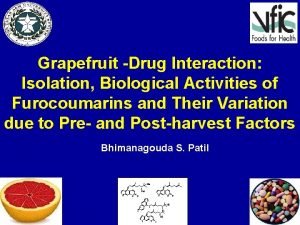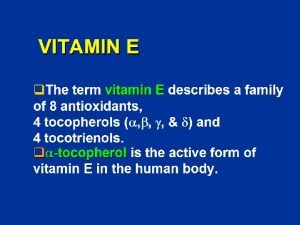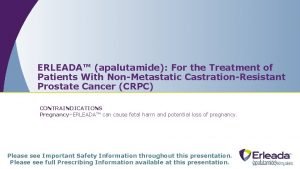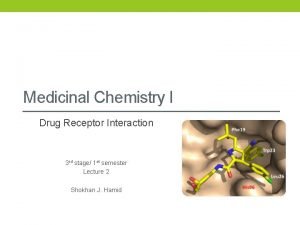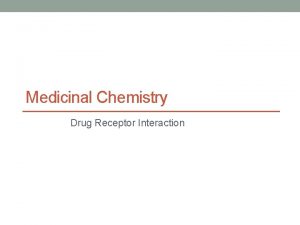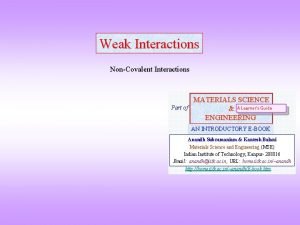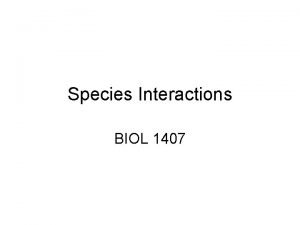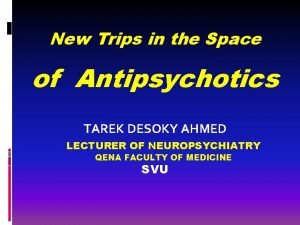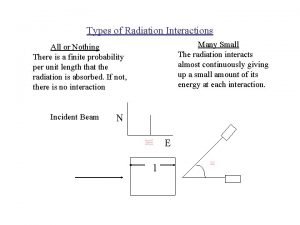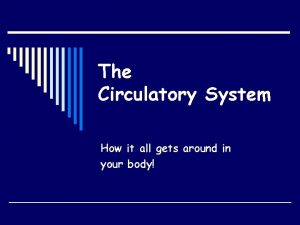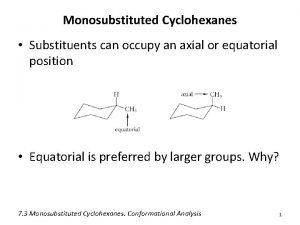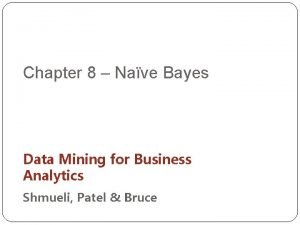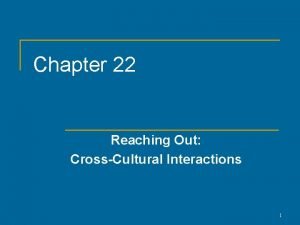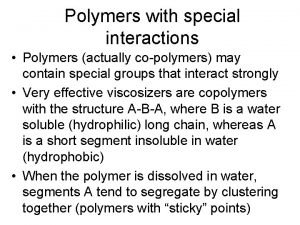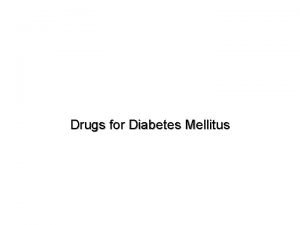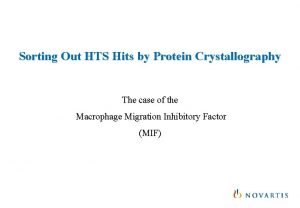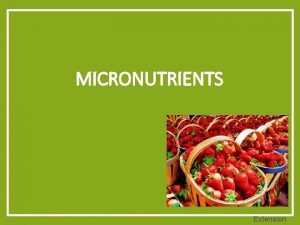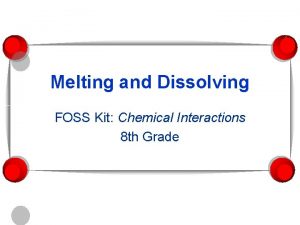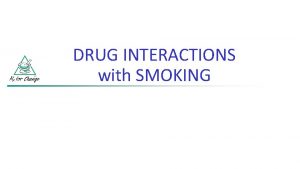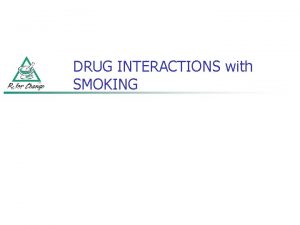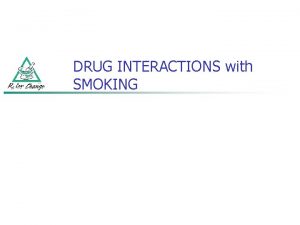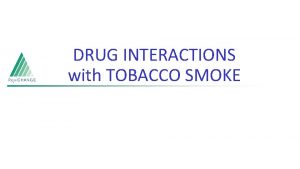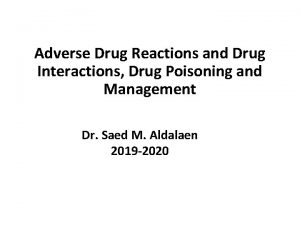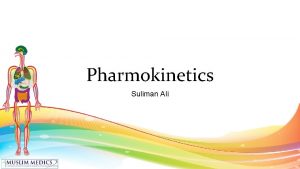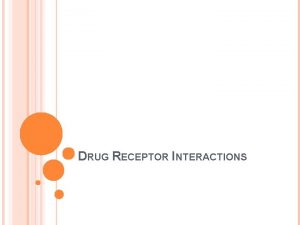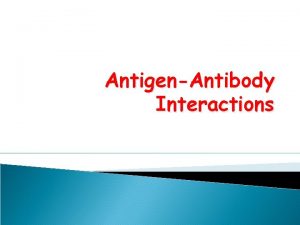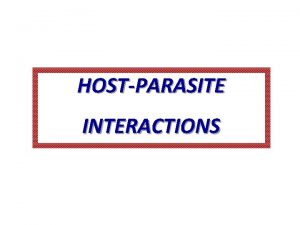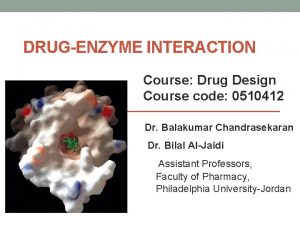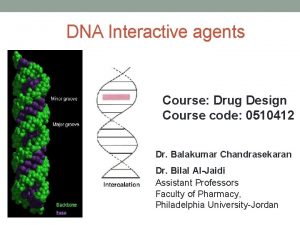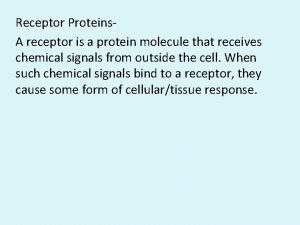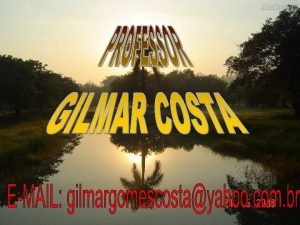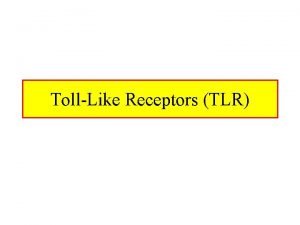DRUG RECEPTOR INTERACTIONS Course Drug Design Course code












































- Slides: 44

DRUG RECEPTOR INTERACTIONS Course: Drug Design Course code: 0510412 H O Dr. Bilal Al-Jaidi H O H N H Binding site H Me O 2 C Dr. Balakumar Chandrasekaran Assistant Professors, Faculty of Pharmacy, Philadelphia University-Jordan

LEARNING OUTCOMES At the end of this lesson students will be able to Ø Define and describe the drug targets and drug binding. Ø Explain various drug-receptor interactions such as q Covalent bonding q Ionic (electrostatic) interaction q Dipole-dipole interaction q H-bonding q Hydrophobic interaction q Van der Waals forces. Ø Define and describe agonists and antagonists for receptors.

HOW BODY DO ITS JOBS Main systems of the body are: CNS: - Sympathetic - Parasympathetic Signals move through [polarizationdepolarization] mechanism. Liver: - Detoxification process - Storage device. Hormones: - From where they produced How they work To understand all this you have to understand the molecular level of body organization.

CELL

DRUGS TARGETS q Macromolecules such as: 1. Proteins (mainly enzymes, receptors and transport proteins) 2. Lipids 3. Carbohydrates 4. Nucleic acids (DNA and RNA) are the main molecular targets for drugs. q For a drug to have an action, it should interact [bind] with one of these molecules. The area of the macromolecule where the interaction takes place is called the binding site; which is a pocket or canyon at the surface of the macromolecule. q Drug-target interactions can be grouped into two types: 1 Permanent (Irreversible) - covalent bonding (strength of 200 -400 KJ/mol). 2 - Reversible – by different types of interactions q

HOW BINDING TAKES PLACE Binding occur through points of attachment, for a chemical compound they are the functional groups. Functional groups use their electronic & shape characters in the binding process. Bonds could be inter-molecular or intramolecular. If we talk about reversible binding, binding of drug to receptor should be in equilibrium state.

EXAMPLE The protein The active site The drug

RECEPTOR-DRUG INTERACTION Receptors are mostly membrane-bound proteins that selectively bind small molecules called ligands which results in physiological response. They are difficult to isolate because they exist in tiny amount and if isolated it will be difficult to purify.

Overall Process of Receptor/ Messenger Interaction M M M RE R RE Signal transduction ü Binding interactions must be strong enough to hold the messenger sufficiently long for signal transduction to take place. ü Interactions must be weak enough to allow the messenger to depart. ü Implies a fine balance.

RECEPTOR-DRUG INTERACTION The driving force for drug-receptor interaction is the low energy state of the drug-receptor complex. The biological activity is related to the drug affinity for the receptor, i. e the stability of the complex. Dissociation constant of the drug-receptor complex gives an idea a bout how potent is the drug.


The protein surface contains an area which has the correct shape to accept the incoming messenger. This area is known as the binding site and is analogous to the active site of an enzyme. But unlike enzymes, chemical messenger does not undergo a chemical reaction. It fits into the binding site of the receptor protein, passes on its message and then leaves unchanged. Ligand receptor interaction involves the same bonding types that are for drug-enzyme interaction.

RECEPTOR-DRUG INTERACTIONS Includes: Covalent bonding Irreversible bond Ionic (electrostatic) interaction Dipole-dipole interaction H-bonding Charge-transfer interactions Hydrophobic interaction Van der Waals forces Reversible bonds

COVALENT BONDS Strong, irreversible bonds (-40 to -110 Kcal/mol stability). Rarely More seen in drug-receptor interaction. prevalent in drug-enzyme and drug. DNA interaction.

COVALENT BONDS For covalent bond formation, there should be two poles; the electrophile and the nucleophile. � Nucleophiles groups: in biology have the following functional Thiol in the amino acid cysteine Hydroxyl in the amino acid serine Amine in the amino acid lysine Carboxylate in the amino acid glutamic acid. � Electrophiles Epoxide ring Alkyl group attached to halogen Positively charged centre

IONIC OR ELECTROSTATIC INTERACTIONS This type of bond is weaker than covalent bond (-5 Kcal/mol). At the same time, it is one of the most prevalent bonds in drug-receptor interaction. The drug molecule must have opposite charge compared to the ionized amino acids found in the receptor or enzyme. � Extent of ionization affects the occurrence of this bond. � The distance between opposite charges has a role as well.

EXAMPLE In biological systems, it happens between residues having carboxylate group such as aspartic acid & glutamic acid (acidic amino acids), and aminium ions such as Histidine, Lysine and Arginine (basic amino acids). Antidepressant drug pivagabine

ION-DIPOLE AND DIPOLE-DIPOLE INTERACTIONS Electronic dipole is formed when we have polarized bond due to electronegativity of atoms. In the polarized bond one of the pole will be partially positive and the other partially negative. These partially positive or negative charges might form an electrostatic bond with either partially charged atoms or ionized elements.

Ion-dipole occur when an ionic group on one molecule interacts with a permanent dipole on a second molecule. It is stronger than dipole-dipole interactions (decreases relative to the square of separation). This type of interaction has the energy -1 to -7 Kcal/mol). Example of Drug: Zaleplon (treat insomnia).

H-BONDING Should have H-Bond acceptor (the electron rich atom, slightly negative) and H-Bond donor (electron-deficient hydrogen, slightly positive). Stability of this bond is -1 to -7 kcal/mol H-bonds are between 1. 5 -2. 2 Å.

Increase electron density, better H-Bond acceptor, so anions are better than uncharged compounds e. g. carboxylate anion.

If the lone pair on nitrogen atom are delocalized, this will weaken the HBD capacity H-Bond donors are better if the H is more electron deficient by attachment to more electron deficient atom such as quaternary ammonium compounds.

Two types of H-bonding: �Intramolecular H-bonding: which occur within the same molecule. �Intermolecular H-bonding: occurs between two nearby molecules

The occurrence of intramolecular H-bonding could affect the pharmacological action of a drug: � P-hydroxybenzoate has more potent antibacterial action compared to methyl salicylate, it is normally used as food additive as preservative.

CHARGE-TRANSFER INTERACTIONS Occurs between an electron donor group in one molecule and an electron acceptor in another. � Electron donors such as alkenes, alkynes and aromatic ring bearing an electron donating group, and atoms having pairs of non-bonded electrons such as O, N and S � Electron acceptors such as aromatic ring bearing an electron withdrawing group, � These groups might exist in the receptor binding sites: Electron donor such as aromatic ring of tyrosine and carboxylate group of aspartate. Electron acceptor: cysteine Having both: Histidine, tryptophan and Asparagine.

CHARGE-TRANSFER BONDS

HYDROPHOBIC INTERACTIONS q When two nonpolar groups (lipophilic group on a drug and a nonpolar receptor group, each surrounded by ordered water molecules which become disordered in an attempt to associate with each other. q This increase in entropy, therefore, results in a decrease in the free energy (ΔG = ΔH − TΔS), which stabilizes the drug–receptor complex. q This stabilization is known as a hydrophobic interaction.

HYDROPHOBIC INTERACTIONS Example of hydrophobic interactions Hydrophobic interactions are responsible for noncovalent intermolecular interactions in aqueous solution.

HYDROPHOBIC INTERACTIONS q Another type of hydrophobic interactions is called as π-π interaction. q This involve a parallel arrangement of aromatic rings in which the π-electrons interact in a face-to-face arrangement. Example: Anticonvulsant drug Lacosamide has phenyl ring (π electrons) The receptor has phenyl alanine contains the phenyl ring (π electrons)

VAN DER WAALS FORCES Occurs due to temporary non-symmetrical distribution of electron density, this will form temporary dipole that will interact with nearby dipole. Stability accounts for only -0. 5 kcal/mole, this means that this type of bonds are much weaker than other bonds.

EXAMPLE OF POTENTIAL MULTIPLE DRUG– RECEPTOR INTERACTIONS Dibucaine, the local anaesthetic drug exhibits variety of interactions.

RECEPTOR’S AGONIST Agonists mimic the natural messenger of a receptor. Agonists bind reversibly to the binding site and produce the same induced fit as the natural messenger - receptor is activated. Similar intermolecular bonds formed as with natural messenger. Agonists are often similar in structure to the natural messenger.

RECEPTOR’S AGONIST To design an agonist you have to know: � The geometry and topography of the active site and /or. � The chemical structure (preferably the 3 D structure) of the normal substrate that act upon. Requirements for agonist design: � The agonist must have the correct binding groups. � The binding groups must be correctly positioned to interact with complementary binding regions. � The drug must have the correct shape and size to fit the binding site

The agonist must have the correct binding groups.

The binding groups must be correctly positioned to interact with complementary binding regions.

The drug must have the correct shape and size to fit the binding site


RECEPTOR’S ANTAGONIST Strategies to design an antagonists: � is to design a drug that has the right shape to bind to the receptor site, but which would fail to change the shape of the receptor

RECEPTOR’S ANTAGONIST Strategies to design an antagonists: � Allosteric antagonists

RECEPTOR’S ANTAGONIST Strategies to design an antagonists: � Antagonism by the 'umbrella’ effect: Here the drug will bind to a region close to binding site, once bound, part of its structure (tail) will cover the opening of the binding site. . preventing the normal messenger from accessing the binding site

Competitive Antagonists: Compete with agonist for receptor binding => Agonist appears less potent, but can still achieve 100% effect but at higher concentrations. Non-competitive Antagonists: Bind to receptor at different site and either prevent agonist binding or the agonist effect => maximal achievable response reduced.

AFFINITY, EFFICACY, AND POTENCY Affinity: how strongly the drug binds to the receptor; depends on the molecular complementarily of drug and receptor. Efficacy: the maximum biological effect the drug can produce. A compound with high affinity does not necessarily have high efficacy (e. g. antagonists). Potency: the amount of drug needed to achieve a defined biological effect. The smaller the dose required, the more potent the drug. It is possible to have potent drugs with low efficacy. Potency depends in part on the affinity of the receptor for binding the drug, and in part on the efficiency with which the drug-receptor interactions is coupled to response.

Recommended Books 1. The organic chemistry of drug design by Richard B. Silverman. Second edition, Elsevier, 2004. 2. An introduction to Medicinal Chemistry by Graham L. Patrick. Fourth edition, Oxford, 2009. 43

 Felodapine
Felodapine Ppi omeprazole
Ppi omeprazole Diazepam cyp450
Diazepam cyp450 Beri beri
Beri beri Janssen carepath savings program
Janssen carepath savings program Drug receptor interaction medicinal chemistry
Drug receptor interaction medicinal chemistry Drug-receptor interaction
Drug-receptor interaction Busceral
Busceral Exhausted drug meaning
Exhausted drug meaning Noncovalent interactions
Noncovalent interactions Congress formal and informal powers
Congress formal and informal powers 5 types of symbiosis
5 types of symbiosis Wikimedia commons
Wikimedia commons Words images objects qualitative or quantitative
Words images objects qualitative or quantitative Sertraline interactions
Sertraline interactions Monetary and fiscal policy interactions activity 5-5
Monetary and fiscal policy interactions activity 5-5 The properties and interactions of magnets
The properties and interactions of magnets Interactions within ecosystems grade 7
Interactions within ecosystems grade 7 Examples of abiotic factors
Examples of abiotic factors Sphere interactions
Sphere interactions Section 20-1 review species interactions
Section 20-1 review species interactions Plant system interactions worksheet answers
Plant system interactions worksheet answers 6.1 habitats, niches, and species interactions answer key
6.1 habitats, niches, and species interactions answer key Types of interactions
Types of interactions Circulatory system interactions with other systems
Circulatory system interactions with other systems Modular vs integral product architecture
Modular vs integral product architecture Diaxial interactions
Diaxial interactions Factors affecting the communication process
Factors affecting the communication process Symbiosis and species interactions keystone webquest
Symbiosis and species interactions keystone webquest Circulatory system interactions with other systems
Circulatory system interactions with other systems Naive bayes pays attention to complex interactions and
Naive bayes pays attention to complex interactions and Chapter 22 reaching out cross-cultural interactions
Chapter 22 reaching out cross-cultural interactions Integral vs modular design
Integral vs modular design Special interactions
Special interactions Glipizide interactions
Glipizide interactions Chapter 22 reaching out cross-cultural interactions
Chapter 22 reaching out cross-cultural interactions Chapter 22 reaching out cross-cultural interactions
Chapter 22 reaching out cross-cultural interactions Accounting information system chapter 1
Accounting information system chapter 1 Unit 5 ecology
Unit 5 ecology Heterotrophs
Heterotrophs Hccee
Hccee Nutrient interactions
Nutrient interactions Foss chemical interactions
Foss chemical interactions Niches and community interactions
Niches and community interactions Interactions
Interactions
